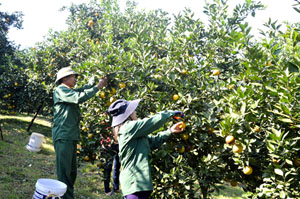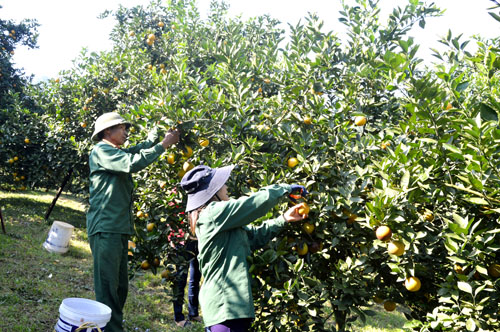
(HBO) - Cao Phong oranges in the northern mountainous province of Hoa Binh have won the trust of consumers nationwide thanks to the locality’s efforts to protect the Cao Phong orange brand name by ensuring product quality.
100 percent of
Cao Phong oranges are safe
Statistics
released by the Cao Phong district agriculture and rural department office show
that as of February 2017, the locality has about
2,080 ha of citrus trees,
of which
417 haare mandarin;
1,367 haare orange and
296 haare pomelo. The total area of small trees is about
1,178 ha while mature
trees account for some
900 ha.
In 2016, Cao Phong harvested more than 23,000 tonnes of citrus fruits which
were sold at an average price of 25,000-35,000 VND per kg.

Producing
organic oranges to meet consumers’ demands is the main plan in Cao Phong.
Photo: Farmers in Cao Phong town harvest oranges in the 2016-2017 crop.
Oranges and mandarins in Cao Phong are
harvested in different periods, from August to May of the next year. According
to Bui Van Dong, deputy head of the Cao Phong district agriculture and rural
development office, the consumption of Cao Phong oranges depends on the free
market, through private traders and wholesale markets. However, the consumption
market has been expanded as a result of the district’s communications campaigns
aiming to encourage local farmers to produce safe products. To prepare for the
second Cao Phong orange festival in November 2016, the district People’s
Committee worked with the Vietnam Certification Centre (Quacert) under the
Directorate for Standards, Metrology and Quality, Ministry of Science and
Technology to take random samples of oranges from stores in the district to
assess their quality. All the samples satisfied safety standards.
Changing ideas
about organic orange production from the smallest deeds
This is the main
target set by Cao Phong authorities and farmers. Bui Van Dong said that
acknowledging the increasing demand for organic oranges, in 2014, the district
People’s Committee teamed up with
Quacert to plant oranges following VietGap standards. At first, only 15
households in the district joined the programme with a total area of
49.8 ha. The figure
increased to 120 households at the end of February 2017 with about
142 ha and an output of
3,000 tonnes. The programme was implemented in Thu Phong, Bac Phong, Tan Phong,
Yen Lap, Nam Phong and Dung Phong communes.
According to Bui
Van Dong, the programme has attracted many households although it requires them
to follow up to 69 criteria. Apart from the 120 households, the district has
called on more households to participate in the programme in 2017, aiming to
have half of its orange areas at VietGap standards. The move shows that the
district is striving to protect its orange brand name by ensuring product
quality. Conforming to VietGap standards has helped local households raise the
competitiveness of their products to access strict markets.
Ta Dinh Thao, a
farmer in 5B zone, Cao Phong town, said joining the VietGap practice, they
ensure strict requirements regarding fertilisers and pesticides. Farmers have
to undergo compulsory training courses on production which is recorded in
detail everyday. For example, they used to fertilise orange trees without
composting. Now, it is compulsory to rot
manure for a period of time.
Bui Van Dong
said the Cao Phong district agriculture and rural development office has
reinforced inspections over orange production and following VietGap. The office
has asked agencies to punish violations of regulations regarding the amount of
heavy metals, pesticides and microorganisms in products to provide organic
fruit for consumers./.
Manh Hung
According to data from the Hoa Binh Provincial Party Committee, the industrial production index for the first six months of 2025 is estimated to have increased by 20% compared to the same period last year. This marks the highest year-on-year growth rate for this period since 2020.
In the first six months of 2025, Hoa Binh province’s export turnover was estimated at 1.145 billion USD, marking an 18.11% increase compared to the same period in 2024. Import turnover was estimated at $ 804 million, a 17.15% increase, which helped the province maintain a positive trade balance.
The lives of the ethnic minority farmers in Tan Lac district have gradually improved thanks to the new directions in agricultural production. This is a testament to the collective strength fostered through the professional associations and groups implemented by various levels of the district’s Farmers’ Union.
With the motto the "product quality comes first,” after nearly one year of establishment and operation, Muong village’s Clean Food Agricultural and Commercial Cooperative, located in Cau Hamlet, Hung Son Commune (Kim Boi district), has launched reputable, high-quality agricultural products to the market that are well-received by consumers. The products such as Muong village’s pork sausage, salt-cured chicken, and salt-cured pork hocks have gradually carved out a place in the market and they are on the path to obtaining the OCOP certification.
In the past, the phrase "bumper harvest, rock-bottom prices" was a familiar refrain for Vietnamese farmers engaged in fragmented, small-scale agriculture. But today, a new spirit is emerging across rural areas of Hoa Binh province - one of collaboration, organisation, and collective economic models that provide a stable foundation for production.
Maintaining growing area codes and packing facility codes in accordance with regulations is a mandatory requirement for agricultural products to be eligible for export. Recently, the Department of Agriculture and Environment of Hoa Binh province has intensified technical supervision of designated farming areas and packing facilities to safeguard the "green passport" that enables its products to access international markets.



